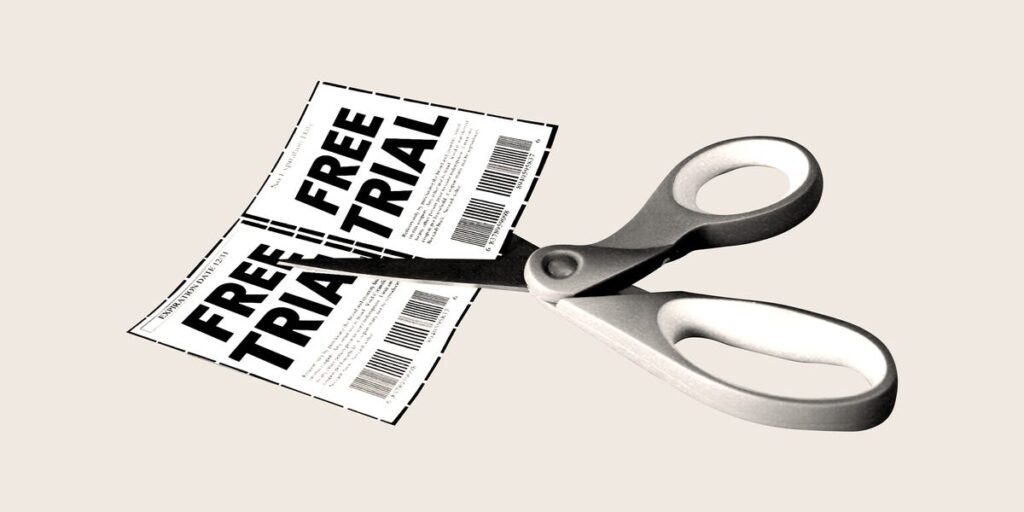People will put in serious effort to save money. In the past, that meant clipping coupons out of the newspaper to score a sweet deal on toothpaste or steaks. Nowadays, however, the coupon is dead. I mean, if you still want to sit around with a pair of scissors on weekends scanning for deals, God bless, but the practice is becoming obsolete. Marketers sent about 50 billion coupons in 2024, an enormous drop from 330 billion in 2010, and less than 2% were even redeemed. So what’s an enterprising cost-cutter to do? Enter, free trials.
The subscription economy has exploded in recent years, by one estimate growing by over 400% over the past decade. Companies love the idea of recurring revenue and sticky customer contracts that require some effort to escape. Given the allure, it’s no surprise that subscription revenue is expected to reach $1.5 trillion this year. Companies have developed a slew of ways to get us on the recurring-charge hook. One of the most popular methods of customer acquisition is free trials, which operate on the idea that a little taste of a service will persuade people to sign up fully, or maybe they’ll just forget about it and keep paying anyway. And once people are hooked, some companies make it harder than it should be to cancel.
“You do feel like you have to have your wits about you, I think, in the world of subscriptions as a consumer,” says Robbie Kellman Baxter, a consultant for subscription-based companies.
The takeoff of hard-to-get-out-of subscriptions has been accompanied by a takeoff of crafty consumers finding ways to wiggle free of them. Shrewd customers are constantly starting and stopping new free and discounted subscriptions as a way to beat the Man. It takes a bit of work, but given companies’ proclivity to keep people trapped in agreements, some people turn around and think, “Well, two can play at that game.”
“Consumers are way more savvy about subscription free trials and deep discounts and are gaming the system more and more, to the point that it’s become an issue for many subscription businesses,” Baxter says.
In subscriptions, it’s turned into an us-versus-them situation. They are hoping we won’t have the wherewithal to click (a few times) to cancel. We are hoping those multiple calendar reminders to log into the random email we created last month and QUIT PEACOCK at the end of the trial will work.
The litany of tactics people employ to try to game the free trials system ranges from elementary to borderline obsessive. People create new email accounts or get a friend or family member to chip in theirs. They set up reminders for themselves to quit before they have to cough up cash, an imperfect system at best. A friend of mine recently confessed he unlocks one of his credit cards only when he signs up for a subscription or books a restaurant reservation with a cancellation fee. He immediately locks it again, so if another charge comes in, it doesn’t go through. He calls it his “f-you card.”
Stephen Carlson, a designer in New York, finds himself on the more sophisticated end of the shenanigans spectrum. He sets up payments using Privacy.com, which allows users to create temporary, anonymous card numbers connected to their bank account and set charge limits and expiration dates. So, he’ll open an account, assign a dummy card to it, and then make it so the card expires right after the trial ends. The alert that the payment has been declined serves as a reminder that he opened the account in the first place, and he can decide from there whether to pay it or let it lapse. Privacy’s dashboard also lets him track which cards he has open and what subscriptions they’re assigned to, so he can monitor whether charges go up and see what he’s signed up for.
“The goal is to just not sign up for things and then forget about them while still paying for them, which is what I think subscription companies plan on,” Carlson says.
I don’t have any ethical qualms with it.
Devin Boudreaux, a digital marketer in Idaho, waits for shows and movies he’d like to watch to stack up on different streaming services so he can sign up, binge, and quit. Apple TV+, specifically, is a good target for this, because they “don’t necessarily ramp up a lot of content frequently,” he says. He just cycles through different emails, which are easy enough to create, and it’s not like delivery platforms or media companies seem to closely track IP addresses or even physical addresses. “I feel like it’s realistically not necessarily saving that much money, but it’s like, oh, this is really easy, it takes two seconds, more or less, and I do think that little things do add up,” he says.
Kaitlin Aviles-Castillo, a product marketer in Connecticut, tells me she views free trials on food delivery and workout passes as a “sweet treat” she rewards herself with from time to time. Given the increasing price for many of these services, she doesn’t feel like she can stay attached over the long run, so she dips in and out as needed. Plus, companies often give newbies better deals than their longtime customers, making new sign-ups more valuable. Ashley Swett, a California account executive who has a habit of signing up for FuboTV trials to catch college football games, echoes the point on price. “Subscriptions have gotten so pricey these days, and there’s so many,” she says.
One of my coworkers, a self-described “fiend for a deal” who’s constantly scanning Facebook and Telegram groups for discounts, tells me that if I just move the dot around in my Gmail address, it’ll still show up in my inbox, but a subscription company will read it as a totally new email. “I don’t have any ethical qualms with it,” she says. “I get what they’re trying to do.”
Plenty of people feel just fine engaging in some level of strategy around subscriptions. In an online survey conducted in May 2024 by The Harris Poll on behalf of Zuora, a software company focused on subscription services, 36% of US adults said they’d canceled and rejoined the same service within a year, and 57% said they’d subscribed to a streaming service in order to watch a specific series or event and then canceled.
Free trials — when done right — can be a win-win.
Consumers get to experience something they were on the fence about and decide whether it’s worth paying for. If they enjoy it and wind up sticking around, the seller gets the bang for the buck they lost by temporarily giving the thing away for free. But trials play into our psychology in other, less mutually beneficial ways.
Neale Mahoney, a Stanford economist who’s studied subscriptions, explains that free trials take advantage of what behavioral economists call myopia or hyperbolic discounting, which is basically a nearsightedness on the part of consumers. We focus on the five free meals offered by the meal kit service, or the teaser rate on the credit card offer, and we view the charges that might come next as a later problem. They also leverage inertia. Many subscriptions are easy to get into and hard to get out of, hence the Federal Trade Commission’s recently blocked attempt to compel companies to make canceling easier. Companies are constantly figuring out ways to get people to sign up and keep them from leaving. Just look at Amazon’s Project Iliad, which was meant to make it hard for consumers to cancel Prime memberships. Mahoney says companies are constantly testing ways to keep people subscribed — how to convince them to sign up, keep them from quitting, and identify price points that will keep them hooked, including extra-low offers if they try to leave. The investment in constantly testing out new methods of retention is worth it, he says, because “they can collect more money than it costs them.” The subscription inertia is so strong that companies such as Rocket Money are making money helping people to track and cancel their subscriptions (the service is a subscription, of course).
Consumers are on the lookout for how companies are going to try to squeeze the most money out of them, and so they’re engaging in their own ruses in turn.
Free trials are a tempting type of “negative option” business practice, in which companies interpret a customer’s lack of action on a subscription as consent to keep billing. In some areas, they make sense — I don’t want to have to tell T-Mobile I still want to use my cellphone every month. But they can also be sneaky and lull people into paying for stuff much longer than they’d intended. One research paper that Mahoney coauthored found that adding some level of friction to the subscription cancellation process raised revenues for companies by 14% to 200%.
“Companies don’t need most people to forget to cancel,” says Ayelet Fishbach, a professor of behavioral science and marketing at the University of Chicago. “Just a few is enough.”
A lot of people have at least one subscription cancellation nightmare story. I’ve got a bunch. A few months into the pandemic, my gym told me I couldn’t quit my membership unless I came in person or sent them a certified letter in the mail saying I wanted out. Regular mail, apparently, didn’t cut it. Earlier this year, I spent months calling a small publication trying to cancel a subscription I didn’t even remember signing up for, and I eventually had to call my credit card company to block them from charging me. Sometimes, I’ve played the system, too. Recently, I got a $100 voucher in the mail to order a case of wine. I did a little online research and discovered the catch was that if I ordered the wine, the company would sign me up to be a monthly donor to its winemakers, which was not very obvious in its original order. Since they were trying to trick me, I decided to trick them back — once the wine arrived, I immediately canceled my membership.
Our consumer economy has trained us to act this way. Consumers are on the lookout for how companies are going to try to squeeze the most money out of them, and so they’re engaging in their own ruses in turn. On free trials, some of the pros on the subscriptions side even acknowledge that you really can’t blame consumers for acting like this.
Amy Konary, who heads a think tank at Zuora, says free trial subscriptions should serve as “feedback” for businesses that the product or service they’re trying to sell isn’t worth the price they’re charging in a prospective customer’s mind. “There should not be any trickery on any side, and no one should be feeling guilty about anything,” she says. “Any type of a merchant-consumer relationship is an exchange of fair value.”
“The value proposition is not compelling,” Baxter says. “And I think a lot of organizations do a free trial because nobody’s buying, nobody’s signing up.”
That doesn’t mean scheming around free trials is a victimless crime. Mahoney says there’s a “reverse Robin Hood” element to the issue, and not the type you may think. The people who have the time and energy to game free trial systems are most likely more sophisticated and higher-income than the people who do not. That may lead companies to increase their subscription costs and make quitting a little more difficult, and it ultimately hurts less sophisticated, lower-income people who aren’t playing any games. It also hurts the more sophisticated people who are wasting all this time to squeeze an extra $5 out of Hulu.
“So many things about that economy are just problematic,” Mahoney says. “You don’t want to hurt unsophisticated low-income people, and you don’t want a bunch of people just spending their time playing games. It’s not productive.”
Emily Stewart is a senior correspondent at Business Insider, writing about business and the economy.
Business Insider’s Discourse stories provide perspectives on the day’s most pressing issues, informed by analysis, reporting, and expertise.
Read the full article here
















